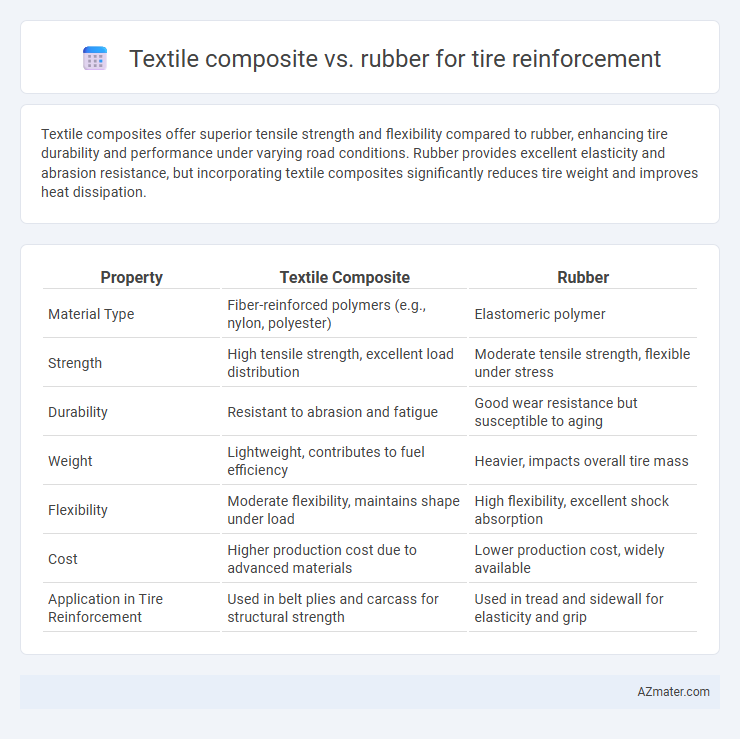Textile composites offer superior tensile strength and flexibility compared to rubber, enhancing tire durability and performance under varying road conditions. Rubber provides excellent elasticity and abrasion resistance, but incorporating textile composites significantly reduces tire weight and improves heat dissipation.
Table of Comparison
| Property | Textile Composite | Rubber |
|---|---|---|
| Material Type | Fiber-reinforced polymers (e.g., nylon, polyester) | Elastomeric polymer |
| Strength | High tensile strength, excellent load distribution | Moderate tensile strength, flexible under stress |
| Durability | Resistant to abrasion and fatigue | Good wear resistance but susceptible to aging |
| Weight | Lightweight, contributes to fuel efficiency | Heavier, impacts overall tire mass |
| Flexibility | Moderate flexibility, maintains shape under load | High flexibility, excellent shock absorption |
| Cost | Higher production cost due to advanced materials | Lower production cost, widely available |
| Application in Tire Reinforcement | Used in belt plies and carcass for structural strength | Used in tread and sidewall for elasticity and grip |
Introduction to Tire Reinforcement Materials
Tire reinforcement materials primarily include textile composites and rubber, each offering distinct mechanical properties essential for durability and performance. Textile composites consist of woven fibers such as polyester, nylon, or aramid, providing high tensile strength and flexibility critical for maintaining tire shape and resisting deformation. Rubber compounds contribute elasticity and abrasion resistance, ensuring tire longevity and effective road grip under various driving conditions.
Overview of Textile Composites in Tires
Textile composites in tire reinforcement utilize high-strength fibers such as polyester, nylon, and aramid to enhance durability, flexibility, and performance. These composites offer superior resistance to fatigue, heat, and punctures compared to traditional rubber, improving tire longevity and safety. The integration of textile composites optimizes tire weight and rolling resistance, contributing to better fuel efficiency and handling characteristics.
Characteristics of Rubber in Tire Construction
Rubber in tire construction provides exceptional elasticity, durability, and resistance to abrasion and environmental factors like ozone and UV exposure. It offers superior flexibility, enabling tires to maintain proper grip and absorb shocks on various road surfaces. The inherent viscoelastic properties of rubber improve tire performance by enhancing traction, reducing rolling resistance, and extending overall tread life.
Comparative Mechanical Properties
Textile composites used in tire reinforcement exhibit higher tensile strength and better fatigue resistance compared to traditional rubber materials, enhancing durability under repetitive stress. Rubber offers superior elasticity and impact absorption, contributing to improved ride comfort and shock dampening. The integration of textile composites increases tire rigidity and performance in high-speed applications, while rubber maintains flexibility essential for traction and road grip.
Durability and Longevity: Textile Composite vs Rubber
Textile composites offer superior durability compared to traditional rubber in tire reinforcement due to their high tensile strength and resistance to fatigue and abrasion. The enhanced structural integrity of textile fibers reduces deformation and extends the tire's lifespan under varied load and temperature conditions. Rubber, while flexible and resilient, tends to degrade faster from UV exposure and heat, resulting in shorter longevity compared to textile composite reinforcements.
Impact on Tire Performance and Safety
Textile composites in tire reinforcement offer superior flexibility and tensile strength, enhancing overall tire durability and road grip, which directly improves vehicle handling and safety. Rubber reinforcement provides excellent elasticity and energy absorption, contributing to better shock resistance and ride comfort but may compromise long-term structural integrity under extreme conditions. Combining textile composites with rubber optimizes tire performance by balancing strength, flexibility, and impact resistance, reducing the risk of tread separation and blowouts.
Environmental and Sustainability Considerations
Textile composites used in tire reinforcement offer enhanced recyclability compared to traditional rubber-based materials, reducing overall environmental impact by facilitating material recovery and reuse. Natural fiber-based textiles, such as hemp or flax composites, contribute to sustainability by lowering carbon footprint and dependence on petroleum-derived rubber. Rubber reinforcements, while durable, pose challenges in end-of-life disposal and contribute significantly to microplastic pollution, emphasizing the need for more eco-friendly alternatives in tire manufacturing.
Cost Implications and Manufacturing Processes
Textile composites used in tire reinforcement generally offer lower material costs but involve more complex manufacturing processes like weaving and coating, which can increase production time and labor expenses. Rubber reinforcement materials, particularly steel-belted rubber, tend to have higher raw material costs but benefit from more streamlined, automated manufacturing processes that reduce overall production costs. Balancing the initial material expense with the complexity of manufacturing methods is crucial in optimizing cost efficiency for tire reinforcement applications.
Applications and Use Cases in Modern Tires
Textile composites enhance tire flexibility and reduce weight, making them ideal for passenger cars and performance vehicles requiring improved handling and fuel efficiency. Rubber reinforcement, typically used in heavy-duty and off-road tires, provides superior durability and resistance to abrasion and punctures under extreme conditions. Modern tire designs often combine textile and rubber reinforcements to optimize performance, balancing comfort, longevity, and toughness across diverse driving environments.
Future Trends in Tire Reinforcement Technologies
Textile composites are rapidly evolving in tire reinforcement, offering enhanced durability and weight reduction compared to traditional rubber materials, which primarily provide flexibility and elasticity. Advanced textile fibers such as aramid, carbon, and high-modulus polyester improve tensile strength and thermal stability, critical for electric vehicle tires with higher performance demands. Future trends indicate a shift towards hybrid reinforcements combining textile composites and rubber to optimize both structural integrity and ride comfort, driven by sustainability goals and precision manufacturing techniques like automated fiber placement.

Infographic: Textile composite vs Rubber for Tire reinforcement
 azmater.com
azmater.com